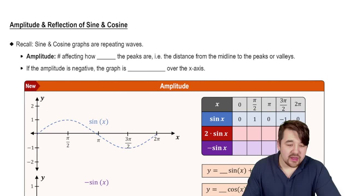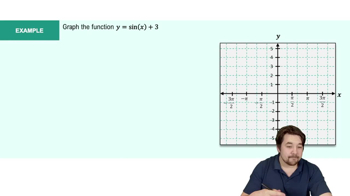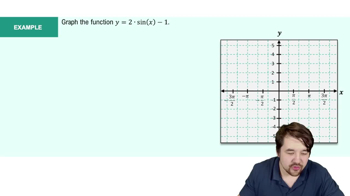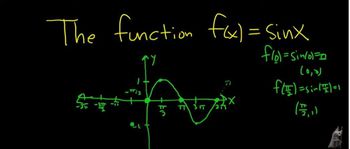Table of contents
- 0. Review of College Algebra4h 43m
- 1. Measuring Angles39m
- 2. Trigonometric Functions on Right Triangles2h 5m
- 3. Unit Circle1h 19m
- 4. Graphing Trigonometric Functions1h 19m
- 5. Inverse Trigonometric Functions and Basic Trigonometric Equations1h 41m
- 6. Trigonometric Identities and More Equations2h 34m
- 7. Non-Right Triangles1h 38m
- 8. Vectors2h 25m
- 9. Polar Equations2h 5m
- 10. Parametric Equations1h 6m
- 11. Graphing Complex Numbers1h 7m
4. Graphing Trigonometric Functions
Graphs of the Sine and Cosine Functions
Problem 4.13
Textbook Question
Graph each function over the interval [-2π, 2π]. Give the amplitude. See Example 1.
y = 2 cos x
 Verified step by step guidance
Verified step by step guidance1
Identify the function type: The given function is a cosine function, specifically \( y = 2 \cos x \).
Determine the amplitude: The amplitude of a cosine function \( y = a \cos x \) is the absolute value of \( a \). Here, \( a = 2 \), so the amplitude is \( |2| = 2 \).
Set the interval for graphing: The problem specifies the interval \([-2\pi, 2\pi]\). This means you will graph the function from \(-2\pi\) to \(2\pi\).
Plot key points: For \( y = 2 \cos x \), identify key points within one period \([0, 2\pi]\) such as \( (0, 2), (\pi/2, 0), (\pi, -2), (3\pi/2, 0), (2\pi, 2) \) and extend this pattern to cover the interval \([-2\pi, 2\pi]\).
Sketch the graph: Use the key points and the amplitude to sketch the cosine wave, ensuring it oscillates between \(-2\) and \(2\) over the specified interval.
Recommended similar problem, with video answer:
 Verified Solution
Verified SolutionThis video solution was recommended by our tutors as helpful for the problem above
Video duration:
0m:0sPlay a video:
Was this helpful?
Key Concepts
Here are the essential concepts you must grasp in order to answer the question correctly.
Amplitude
Amplitude refers to the maximum distance a wave reaches from its central axis. In the context of trigonometric functions like cosine, it indicates how tall the peaks and how deep the troughs of the graph are. For the function y = 2 cos x, the amplitude is 2, meaning the graph oscillates between 2 and -2.
Recommended video:

Amplitude and Reflection of Sine and Cosine
Cosine Function
The cosine function is a fundamental trigonometric function defined as the ratio of the adjacent side to the hypotenuse in a right triangle. It is periodic, with a period of 2π, meaning it repeats its values every 2π units. The graph of y = cos x is a wave that oscillates between 1 and -1, and when multiplied by a coefficient, like 2 in this case, it stretches vertically.
Recommended video:

Graph of Sine and Cosine Function
Graphing Trigonometric Functions
Graphing trigonometric functions involves plotting their values over a specified interval, which helps visualize their periodic nature. For y = 2 cos x over the interval [-2π, 2π], one would plot points at key angles (like 0, π/2, π, etc.) and connect them to show the wave pattern. Understanding the key features such as amplitude, period, and phase shift is essential for accurate graphing.
Recommended video:

Introduction to Trigonometric Functions

 5:53m
5:53mWatch next
Master Graph of Sine and Cosine Function with a bite sized video explanation from Nick Kaneko
Start learningRelated Videos
Related Practice
















